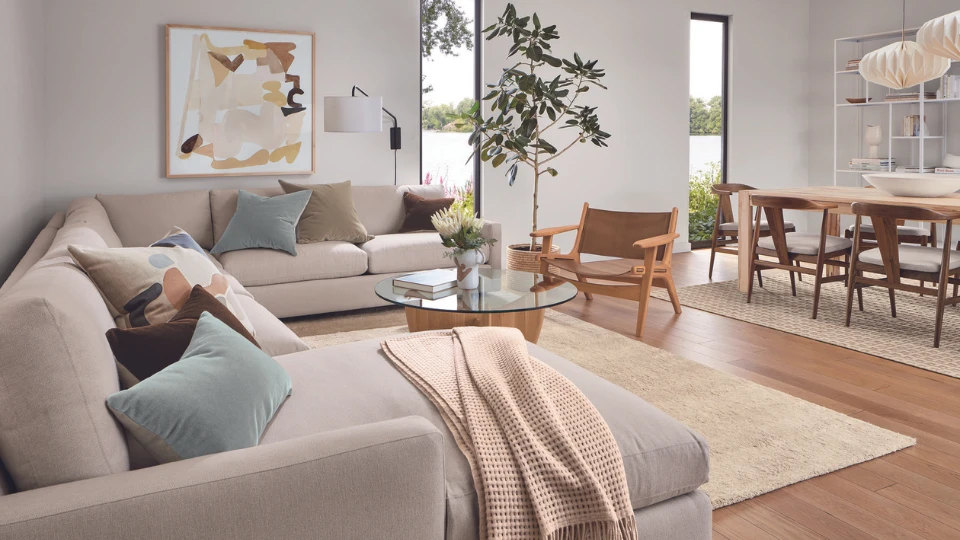
Changemakers: Room & Board
31-Oct-2023
Room & Board’s Linger Sofa is manufactured by American craftspeople in North Carolina.
‘Let’s figure out supply chains and economics to make sustainability the norm, not the exception.’
How Room & Board’s first Director of Sustainability is tackling company-wide change -- with an eye to industry-wide transformation
Interview #5 in the Changemakers series
In this interview, we ask Emily McGarvey – the inaugural Director of Sustainability at Room & Board – about the ‘ins and outs’ of her role. We explore what it will take to achieve company-wide change and, ultimately, industry-wide transformation.
Room & Board is a US-based furniture company that supports local communities and American craftspeople, “manufacturing better products that are better for the planet.” Founded in 1980, the company currently operates over 20 retail stores and has a large on-line presence across the country.
This is the 5th in our Changemakers series – interviews with leaders in sustainable, circular and regenerative approaches in the furniture industry. Our aim is to uncover the nuts and bolts of how each leader is driving change, the potential it holds, and why it matters to the industry.

Left: Director of Sustainability, Emily McGarvey. Right: Minnesota staff members planting trees.
mebl: What led you to Room & Board?
Emily: About two years ago, a friend told me that Room & Board had created a Director of Sustainability position. At the time, I was very happy working as a consultant. But it was an opportunity I couldn’t resist. Room & Board – based in Minneapolis, where I live – has a reputation for an excellent work culture. The staff love working here.
In addition, Room & Board has always placed sustainability at its core – a focus on positive impact throughout their operations. To move sustainability forward, faster, about three years ago, the company retained a consultant who suggested the formation of a dedicated sustainability team - and that’s how my role came into existence.

Room & Board’s sustainability strategic framework in three pillars.
mebl: As Director of Sustainability, what does your day-to-day look like?
Emily: Every day looks different - I enjoy wearing lots of different hats. One day I’m researching bio-based materials - which is part of Better Products, one of three pillars of Room & Board’s sustainability work. The next morning, I’m supporting meetings on diversity, equity, and inclusion - an example of our 2nd pillar, Better for People, and, that afternoon, I might focus on rooftop solar - part of our 3rd pillar, Better for the Planet. This keeps my job very interesting!
Everything I do ultimately ties back to the strategy – our three pillars and nine priorities. My role sets the sustainability strategy which includes ‘mountain-top’ goals, then breaking them up into chunks of work to do quarterly, monthly and daily. Because our goals run across the company, my role as Director of Sustainability involves a lot of teamwork and project management to make sure we are making progress to achieve our goals.
With it still being a relatively new role in the industry, as a Director of Sustainability, I believe you need a self-motivating, entrepreneurial spirit. It’s very much ‘choose your own adventure.’ You decide how to spend your time based on making the most impact for the company’s objectives and strategy.
mebl: How do you decide on new sustainability goals and initiatives?
Emily: It always ties back to our strategy and the triple bottom line - people, planet and profit. Before deciding on a new project, we map the social and environmental benefits and then look at the financials to decide if there's a business case. As we see it, financial gain can come in four forms - there’s tangible benefit, which consists of driving sales or reducing expenses. Or there's an intangible benefit, achieved through increasing brand reputation or decreasing brand risk.
When a decision needs to be made, we pull in the right people and together we weigh the pros and cons. Our decision-making is collaborative – we look to get everyone aligned on the impact we want to make.

Room & Board’s sustainability goals and commitments to improve their impact.
mebl: Tell us about some goals where you’ve made significant progress.
Emily: We have a goal to use 100% renewable electricity in our operations by 2030; we reached 70% at the end of 2022. We also committed to diverting our operational waste to landfill by 75% by the end of 2025, and we estimate that we will have surpassed 80% by the end of 2023.
I’m also proud that 85% of our wood is sustainably sourced, and 90% of our manufacturing takes place in the US. This was a strategic decision made by Room & Board to support American craftspeople when much of the industry shifted abroad.
Room & Board’s Director, Merchandising & Vendor Management, Gene Wilson introducing the Urban Wood Project
mebl: And what are some of the challenges you face?
Emily: One challenge is finding and scaling more sustainable, innovative materials. Within upholstery fabric, for example, we are looking for more bio-based options that have performance attributes that our customers have come to expect. Another example is reclaimed wood, which we use in our urban wood project, and are working to scale in cities across the country. We are working to support more sustainable materials to scale faster.
The end-of-life of furniture is another challenge that we, collectively, don’t have covered. We haven’t built a supply chain that can handle furniture waste. It’s going to take an industry group to foster collaboration and come up with circular solutions for repair, resale, and recycling. There’s a need for a collective voice to move things forward, faster.
Another challenge we are working on is electrifying our delivery fleet. We are starting to see solutions for delivery vehicles with about a 100-mile range and will begin piloting -- starting in California. We are still looking for solutions for long-haul trucks that could travel, for example, from our Otsego, MN distribution center to our Denver, CO delivery center.

The Emmet Chair is a Room & Board circular furniture piece that is Cradle-to-Cradle certified.
mebl: How can we foster this industry-wide transformation?
Emily: We must connect sustainability champions, advocates, and individuals representing their companies - without an official title - who have the passion and permission to make change. Sustainability is still a fairly small profession - especially in furniture. The commercial home furnishings industry is moving faster than the residential side, but there are still too few professionals or dedicated teams leading the way.
We must turn to other industries, like food, apparel, and beauty for solutions that we can adapt and implement. I’ve been attending conferences, summits and events where I see the same people representing their industries. We’ve exchanged details and chats and I ‘phone a friend’ when I’m at a roadblock. Let’s figure out supply chains and economics to make sustainability the norm, not the exception.
mebl: I bet many look to you to learn more about sustainability in furniture; to whom do you look?
Emily: The American Society of Interior Designers (ASID), Mindful Materials, and Sustainable Furnishings Council (SFC) are doing great work pulling people together, and sharing resources to build understanding of sustainability. SFC has industry initiatives to move issues forward like the Wood Furniture Scorecard, as well as their work on harmful chemicals in furniture, through their ‘What’s It Made Of’ initiative.
Metropolis, Green Biz, and Sustainable Brands all publish great newsletters that help me keep up with trends. And then, of course, I’ve attended a couple of mebl | Transforming Furniture’s webinars, like What is the Carbon Footprint of a Piece of Furniture?, to get cutting-edge information.
For hands-on learning, I talk to our vendor partners – for example, many are doing research and implementation. More sustainable solutions can be more challenging in practice as they require an operational change in production.

Room & Board’s 2022 Impact Report
mebl: How do Room & Board employees learn about sustainable practices?
Emily: When new staff members join the company, they participate in a core orientation that consists of about a dozen classes. One of these classes introduces sustainability. For staff who want or need to learn more, we’ve created a series of 3-5 minute videos on a range of topics, such as more sustainable furniture and all staff updates on sustainability progress.
Our company’s annual impact report is available on the sustainability page of our website. The impact report is a great information resource for design associates in Room & Board’s retail stores and our customer care team.
Whenever someone asks me to present on sustainability at a staff meeting, I always say yes. Updating everyone on our sustainability priorities and projects can foster collaboration and transparency between departments.
mebl: Finally, what are you most passionate about achieving at Room & Board?
Emily: At the highest level - I’d like Room & Board to be a force for good that influences the furniture industry. I’d like to see other companies join us to increase the impact. Within the urban wood project, for example, we’re building a circular supply chain - like a highway that we need more cars to drive on.
mebl: Thank you for your time and enthusiasm, Emily!
Room & Board’s commitment to sustainability
READ more Changemaker Interviews here.
